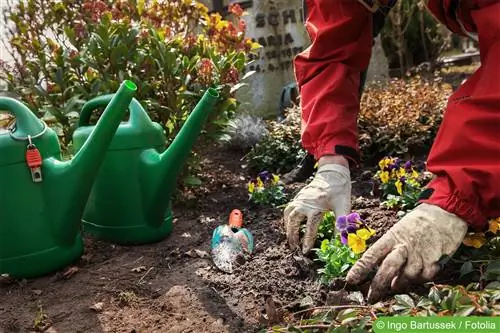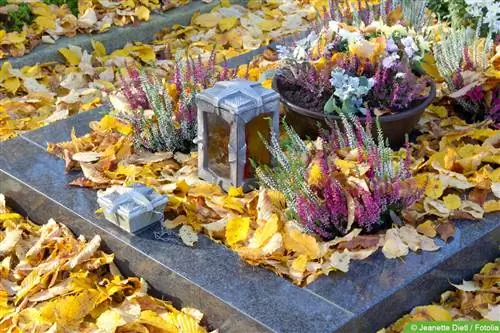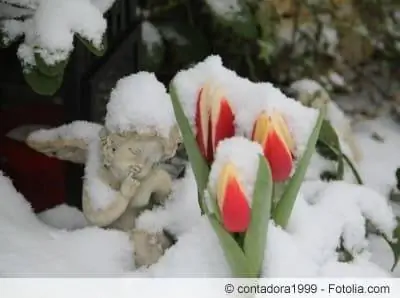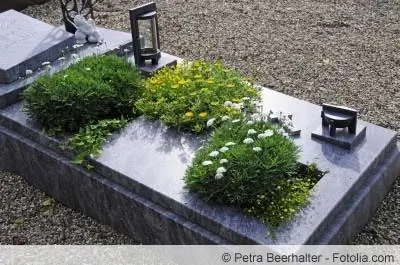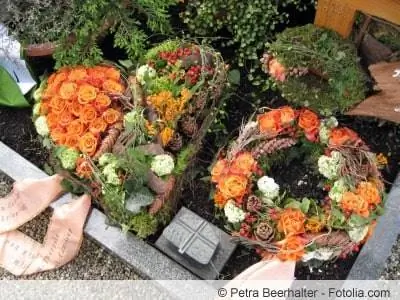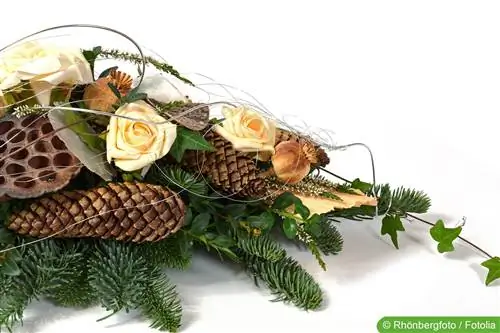- Author admin [email protected].
- Public 2023-12-17 03:39.
- Last modified 2025-01-24 12:45.
Traditionally, the graves are prepared for winter between All Saints' Day (November 1st) until Dead Sunday at the latest. To commemorate the deceased, relatives decorate the grave with stylish arrangements and usually also set up a grave light during the dark season. But what other work needs to be done in winter?
Although there is hardly any snow in many parts of Germany in November and December, cold snaps must be expected every year in January and February at the latest. Therefore, at the beginning of winter it is high time for grave maintenance. The grave must be prepared for frosts, snow and ice. Appropriate decoration is also useful so that the grave looks well-kept even in winter. In winter it is important to use muted colors so that the grave does not appear restless.
Preparing for the first frosts
Seasonal planting with flowering plants is usually withered or wilted in November. Before the grave is decorated for the winter months, all dead plant parts should be cut back and annual plants should be completely dug up and disposed of. If there are large deciduous trees around the grave, it will be necessary at certain intervals to collect the leaves that have fallen on the grave or were blown there by the wind.
- Dig up all annual plants including roots (seasonal planting)
- cut off withered leaves of perennials
- Prune bushes and trees between the end of November and February
New plantings before the first snow
As long as the ground is not yet frozen, you can still plant. Although autumn or spring are better times to redesign the grave, insensitive plants can also be used relatively late in the year. Conifers, evergreen trees or ground cover are also good choices for grave planting. Some of them decorate the grave with colorful berries over the winter, adding a splash of color to the otherwise dreary surroundings. These trees include, for example:
- Redwood dogwood “Sibirica”: red autumn color of the bark
- Red dogwood “Mitwinter Fire”: bright orange bark
- Low berry (Gaultheria procumbens): evergreen ground cover, red berries throughout the winter
- Spindle bushes (creeping spindle, Euonymus frunei): white/green or yellow/green leaves over the winter
- Peat myrtle (Pernettya mucronata): white, pink or red berries from late summer
- Holly (Ilex): red or orange berries
Tip:
Caution is advised with sensitive plants such as boxwood. If planted very late, it cannot adequately prepare for winter and freezes to death in severe frosts.
Seasonal winter planting
Even in the cold season you don't have to go without fresh greenery and flowers. Although the selection is not very large, there are a few flowering plants that are ideal for decorating graves, even in winter. Plants don't have it easy in the cold season because they have to withstand icy winds, ground frost and sometimes a thick blanket of snow. Therefore, only those species that have sufficient winter hardiness may be selected. Winter bloomers include:
- Heather (like common heather, Calluna vulgaris): very robust plant, even blooms continuously in mild winters
- Christmas roses (Helleborus niger): bloom in the darkest and coldest season, some species even before Christmas, flower color in white, yellow and shades of pink
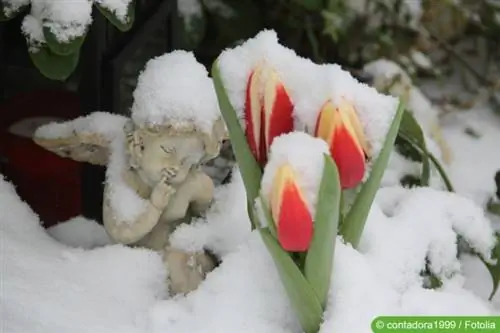
Various shrubs also bloom in winter:
- Winter jasmine: yellow flowers from December to April, protected location
- Winter snowball: pink, fragrant flowers from November
Tip:
Ask specifically about winter bloomers in your cemetery nursery. Here we can often offer you an extensive range and give you good advice.
Insert flower bulbs
At the end of winter, the first signs of spring often appear under a blanket of snow. They include a number of onion plants that also create a wonderful atmosphere on graves. The flower bulbs should preferably be planted in the ground a few weeks before permanent frost. In addition, flower bulbs, which appear as the first signs of spring, are already being planted in the ground. Early flowering bulbous plants include:
- Snowdrop (Galanthus)
- Märzenbecher (Leucojum vernum): is often confused with the snowdrop
- Crocus (Crocus): flower color in yellow, purple, blue, white
- Star hyacinth, snow shine (Chionodoxa): flowers in shades of blue to white
- Squill (Scilla species): mostly blue, sometimes pink or white flowers (March)
- Tulips (Tulipa)
- Easter bells (Narcissus)
Tip:
Onion plants look most beautiful when planted in groups of at least five plants. Entire carpets of 30-50 examples are truly spectacular.
Watering in winter
If there are longer dry periods, the cemetery must be watered regularly, even in autumn and winter. Evergreen plants such as ground cover or conifers in particular suffer when the sun shines and the ground is frozen. However, watering should be done very sparingly in winter to avoid waterlogging. A half to full watering can full of water is usually enough to cover the moisture needs of the plants.
Decoration of the grave
For many people, grave care in winter also includes decoration. If you are preparing your grave for the winter, you should plan to keep a sufficiently large area on the grave free for a flower arrangement or something similar. Simply placed on the branches of the cover or the wintergreen plants, the arrangements or wreaths are not shown to their best advantage. It is better to lay out a stone slab (for example made of the same material as the gravestone) or to sprinkle a designated area thickly with bark mulch (available in different colors). Wreaths can also be attached to a holder so that they stand a little more upright and stand out from the ground.
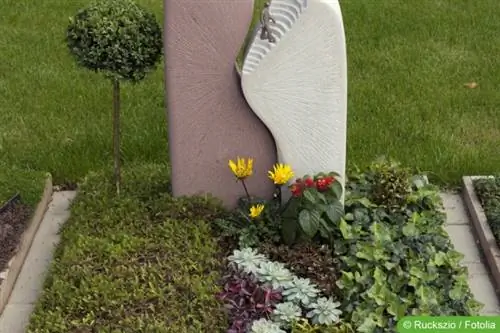
Another way to make a flower arrangement stand out is to make a small mound of earth to place the decoration on.
- only use robust materials (resistant to frost and weather)
- Wreaths or arrangements made from dried plants
- Grave lights or grave lanterns
- Figures (e.g. angels) made of stone or other weather-resistant materials
Tip:
The winter decorations should definitely be secured well so that they are protected from stormy winds in winter.
If no winter planting is desired
A grave does not necessarily have to be replanted in autumn or early winter. And it doesn't always have to be plants that decorate a grave. In some areas it is customary to remove all plants from the ground in November to prepare the grave for winter. So that the grave does not look desolate, it is advisable to cover it with branches. A combination with decorative gravel or chippings has proven particularly effective on double graves, where significantly more area has to be worked on. Beautiful pictures or patterns can be created here that last all winter and require almost no care. This variant is particularly suitable for relatives who have little time to devote intensively to caring for the grave. Before covering the grave, however, the ground should first be carefully loosened and all old roots removed.
Grave cover
A cover with branches not only serves to beautify the bare areas on a grave, but also protects the bulbs, tubers and roots of the plants from frost. Evergreen ground cover plants must not be covered, otherwise moisture may build up underneath and lead to mold formation. Suitable branches:
- Tree of Life
- Fir branches
- Musselcypress
- Juniper
- Holly
- Yew
- Spruce
In mild winters, winter cover is actually not absolutely necessary. Under a thick layer of twigs, the plants underneath rot quickly. However, protection makes a lot of sense in harsh locations for frost-sensitive plants. However, this should never be too thick so that the layer does not appear overwhelming. A thin layer under which the air can circulate well is better.
- Twigs of Nordmann firs look very elegant when they are cut into the smallest possible pieces and placed very close together (like scales).
- Blue firs or yellow-green arborvitae bring different colors into play.
- Different branches such as blue fir, juniper and mountain pine can be laid out in patterns (cross, circle, star, heart, Christmas tree).
Conclusion
If the grave is well prepared for the winter, there won't be much work to do in the cold season. In addition to occasionally checking to see whether a storm has left the grave in disarray, grave maintenance in winter involves watering the plants moderately at larger intervals. Without any plants, a grave looks well-kept if it is covered with evergreen branches. Branches of different conifers can be used to create pretty pictures or patterns that can only be complemented with a wreath, arrangement or fresh bouquet of flowers for the holidays.

